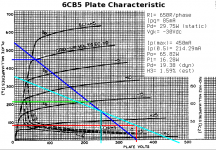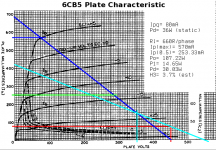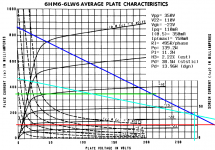Hi,
After building a SE amp and almost building another SE amp (case is done, design testing is done, now I just need to assemble and tweak it), I am looking for information on building a powerful PP amp. I have the idea of using my second SE amp as a preamp (with volume controlled line outputs) for the times I want to watch a movie or just feel like turning the volume up to 11, but use the SE amp for other times.
I would like something around 100W (the speakers I currently have are rated for 90W nominal) maybe a bit more. I also would like to be able to use easily available and inexpensive tubes made in the USSR, however, I cannot get them in matched pairs or whatever. I also would not want to use 1kV plate voltages.
As the output transformer I may be able to use Hammond 1650R (5kPP, 100W, 235EUR/pair), 1650T (1.9kPP, 120W, 235EUR/pair) or 1650W (1.9kPP, 280W, 550EUR/pair), Toroidy.pl TTG-6C33CPP (1.2kPP, 80W, 130EUR/pair) though I am open to suggestions for a similar price. I read somewhere (maybe on this forum) that you should never exceed the power rating of a PP transformer or something may blow up.
The power tubes I have or can easily get are 6S33S, 6P3S (6L6), 6p41S, 6P42S (EL509), 6N13S (6AS7) and maybe others. I do not want to use any semiconductors in the amp - build it with what was available when tubes were mainstream.
As I understand, I will not be able to get that much power out of a single pair of tubes, not unless I find some bigger ones, or use class AB2 (which will complicate the driver design), I will have to use some in parallel. However, all my tubes are unmatched.
Is there a way to use unmatched tubes in parallel in PP? When I build my first SE amp, I used 6AS7 for output with both its triodes in parallel, I used separate cathode resistors (otherwise one of the plates would glow red) and while the triodes draw a bit different currents in idle, the amp sounds good. Can this be done with fixed bias (separate bias to each tube?) or do I absolutely have to use matched tubes? Did people buy matched tubes back when tubes were mainstream?
What would you recommend?
After building a SE amp and almost building another SE amp (case is done, design testing is done, now I just need to assemble and tweak it), I am looking for information on building a powerful PP amp. I have the idea of using my second SE amp as a preamp (with volume controlled line outputs) for the times I want to watch a movie or just feel like turning the volume up to 11, but use the SE amp for other times.
I would like something around 100W (the speakers I currently have are rated for 90W nominal) maybe a bit more. I also would like to be able to use easily available and inexpensive tubes made in the USSR, however, I cannot get them in matched pairs or whatever. I also would not want to use 1kV plate voltages.
As the output transformer I may be able to use Hammond 1650R (5kPP, 100W, 235EUR/pair), 1650T (1.9kPP, 120W, 235EUR/pair) or 1650W (1.9kPP, 280W, 550EUR/pair), Toroidy.pl TTG-6C33CPP (1.2kPP, 80W, 130EUR/pair) though I am open to suggestions for a similar price. I read somewhere (maybe on this forum) that you should never exceed the power rating of a PP transformer or something may blow up.
The power tubes I have or can easily get are 6S33S, 6P3S (6L6), 6p41S, 6P42S (EL509), 6N13S (6AS7) and maybe others. I do not want to use any semiconductors in the amp - build it with what was available when tubes were mainstream.
As I understand, I will not be able to get that much power out of a single pair of tubes, not unless I find some bigger ones, or use class AB2 (which will complicate the driver design), I will have to use some in parallel. However, all my tubes are unmatched.
Is there a way to use unmatched tubes in parallel in PP? When I build my first SE amp, I used 6AS7 for output with both its triodes in parallel, I used separate cathode resistors (otherwise one of the plates would glow red) and while the triodes draw a bit different currents in idle, the amp sounds good. Can this be done with fixed bias (separate bias to each tube?) or do I absolutely have to use matched tubes? Did people buy matched tubes back when tubes were mainstream?
What would you recommend?
Last edited:
Can this be done with fixed bias (separate bias to each tube?)
Since you'll be buying 8 or more output tubes at a time (I would get some spares), you can swap them
around for the best DC matching according to grid bias voltage. It's best to match them for AC gain as well,
but you probably can't do that.
You'll need a small resistor in the cathode circuit of each output tube, from 1-10 Ohms.
Build the fixed bias supply with a pot for each tube, and adjust each for the desired DC bias current.
Then record the grid bias voltages, and match up the tubes as best you can. Make sure you measure
the grid voltage at the wiper, (without loading the grid resistor), and so changing the actual voltage.
Last edited:
Hi,
After building a SE amp and almost building another SE amp (case is done, design testing is done, now I just need to assemble and tweak it), I am looking for information on building a powerful PP amp. I have the idea of using my second SE amp as a preamp (with volume controlled line outputs) for the times I want to watch a movie or just feel like turning the volume up to 11, but use the SE amp for other times.
I would like something around 100W (the speakers I currently have are rated for 90W nominal) maybe a bit more. I also would like to be able to use easily available and inexpensive tubes made in the USSR, however, I cannot get them in matched pairs or whatever. I also would not want to use 1kV plate voltages.
This is definitely do-able, and you don't need the complication of paralleling finals, or outrageous DC rail voltages either. (See attached)
As the output transformer I may be able to use Hammond 1650R (5kPP, 100W, 235EUR/pair), 1650T (1.9kPP, 120W, 235EUR/pair) or 1650W (1.9kPP, 280W, 550EUR/pair), Toroidy.pl TTG-6C33CPP (1.2kPP, 80W, 130EUR/pair) though I am open to suggestions for a similar price. I read somewhere (maybe on this forum) that you should never exceed the power rating of a PP transformer or something may blow up.
These OPTs have impedance transformation ratios that work very well with TV HD finals.
"What would you recommend?"
HD finals: they're cheap, available, and can provide bigwatts at lowish voltages, and they have excellent sonic performance: better than some audio finals, even.
The 6CB5, being an older HD type, needs to be taken inside of Class *2, but it's not a hard load, and a 6SN7-oid as a cathode follower grid driver will work just fine.
6LW6s are as rare as seal feathers these days, due to the demand for these for ham rigs and illegal CB linears. However, there are a lot remaining int he odd heater voltages as these were also designed for use in series strings that ran directly off the AC mains with PTX-less (usually voltage doublers) power supplies. The other than 6.3V heater *LW6s aren't especially $pricey.
Attachments
How do you calculate it? I (more-or-less) know how to calculate the power output of a SE triode amp from tube curves and load lines, but do not know how to do it for pentodes and PP.
EL509 would better for me (since it has a USSR made equivalent - 6P42S) instead of the USA-only *LW6.
I read somewhere that it was possible to get ~70W from a pair of 6S33S in PP and since those tubes have ~60W plate dissipation ratings, I figured that with 35W rating, the 6P42S would not be able to reach that high, therefore I though that I would need to use tubes in parallel unless I managed to get some really big ones.
EL509 would better for me (since it has a USSR made equivalent - 6P42S) instead of the USA-only *LW6.
I read somewhere that it was possible to get ~70W from a pair of 6S33S in PP and since those tubes have ~60W plate dissipation ratings, I figured that with 35W rating, the 6P42S would not be able to reach that high, therefore I though that I would need to use tubes in parallel unless I managed to get some really big ones.
EL509 would better for me......2x EL509/519 per channel into 1k9 would already get you over 100W
The EL509 / 6P42S is supposed to be the same as the US made 6KG6. I can't speak for the European or Russian tubes since I have never seen them, but the US versions can indeed crank out 100 to 150 watts per pair. I tested a pair of 6KG6's in Pete Millett's Engineer Amp and got 150 watts with a 3300 ohm load on 650 volts. Over 200 watts were seen on a 2500 ohm load, but a pale red color appeared on the plate. 100+ watts on 600 volts with a 3300 ohm load should be no problem. Like all TV sweep tubes (line output) the screen grid should be regulated and kept around 150 to 175 volts.
it was possible to get ~70W from a pair of 6S33S in PP and since those tubes have ~60W plate dissipation ratings, I figured that with 35W rating, the 6P42S would not be able to reach that high
The 6S33S is a triode, the 6P42S is a TV sweep pentode. The triode has a higher saturation voltage than a pentode and therefore has higher internal losses for a given output power. TV sweep tubes operate at full power continuously until they die. Therefore the ratings on the US ones at least are a bit conservative.
Several of us modified Pete's amp to make 125 WPC using 6HJ5's, a 24 watt TV sweep tube. My amp still has the original tubes in it nearly 5 years later.
Details are in this long thread
http://www.diyaudio.com/forums/tubes-valves/151206-posted-new-p-p-power-amp-design.html
The screen current depends on the tube and the plate voltage. The AVERAGE screen current can be quite low with the plate voltages needed to get 100 watts (10 to 20 mA). During the signal transients where the plate voltage dips below the screen voltage, the PEAK screen current can go a lot higher.
Usually these numbers can be found on the tube curves.
From the Amperex 6KG6 / EL509 curves found here: http://www.mif.pg.gda.pl/homepages/frank/sheets/084/6/6KG6.pdf
It looks like with 160 volts on G2 and anything over 450 volt on the plate the screen current with no signal will be 10 to 15 mA (hard to tell from the bottom right corner of the plate curves.
The peak plate current determines the saturation voltage. Assuming a 3300 ohm load, which is 825 ohms per plate, and a 600 volt supply, if driven to clipping the peak plate current will be about 725 mA. The tube will saturate at about 30 volts on the plate, and -8 volts on G1. This puts G2 at about 140 mA for that instant.
Big sweep tube amps need screen regulation as do most pentodes at this power level. I use mosfets and zener diodes, but a VR tube feeding a cathode follower would work.
Usually these numbers can be found on the tube curves.
From the Amperex 6KG6 / EL509 curves found here: http://www.mif.pg.gda.pl/homepages/frank/sheets/084/6/6KG6.pdf
It looks like with 160 volts on G2 and anything over 450 volt on the plate the screen current with no signal will be 10 to 15 mA (hard to tell from the bottom right corner of the plate curves.
The peak plate current determines the saturation voltage. Assuming a 3300 ohm load, which is 825 ohms per plate, and a 600 volt supply, if driven to clipping the peak plate current will be about 725 mA. The tube will saturate at about 30 volts on the plate, and -8 volts on G1. This puts G2 at about 140 mA for that instant.
Big sweep tube amps need screen regulation as do most pentodes at this power level. I use mosfets and zener diodes, but a VR tube feeding a cathode follower would work.
You are investing time and money to build an amp. Why then insisting on using cheap
unspecified ( unmatched) tubes from a distant source when perfectly matched
new production tubes from reputable sources are available ?
Well, for one, I do not want to overpay. If I can get a tube for 10EUR instead of 50, then I'll buy the one for 10 (assuming it's the same part number). I also somehow don't think that people bought matched tubes back when tubes were mainstream, so there should be a way to avoid needing them for push-pull circuits. And if Lithuania gets invaded by Russia (again), I may have difficulties getting west-made tubes, while USSR made ones are available now (and usually inexpensive) and would be available then.
I am not trying to build the ultimate sounding amplifier for thousands of Euros - I am trying to build a good sounding amplifier using the technology of the past and trying to not spend too much money. This is the reason I am not using any semiconductors in either of the amps - selenium rectifiers would be OK, but are kinda difficult to get.
Anyway, back to happier thoughts. I'll most likely build a smaller PP amp first - using a pair of 6P3S (I have a bunch of those already, might as well use them) to figure out the PP design and feedback before buying the really expensive transformers and screwing something up.
Miles Prower, how did you calculate the power output and distortion for your suggestions? I know how to calculate the power output for a SE triode, but not PP pentode. Do you know any good site or whatever where I could learn it?
With a pair of 6P36S's, on 4k load, and 500V, you can get around 75W at around 0.3% THD. Of course, a little bit of careful design exercise is needed on the input stages to accomplish this. Using semiconductor CCS's would help a lot, but the OP wants to avoid this, so the figures will be worser.
- Status
- This old topic is closed. If you want to reopen this topic, contact a moderator using the "Report Post" button.
- Home
- Amplifiers
- Tubes / Valves
- Powerful tube amp / unmatched tubes in parallel


